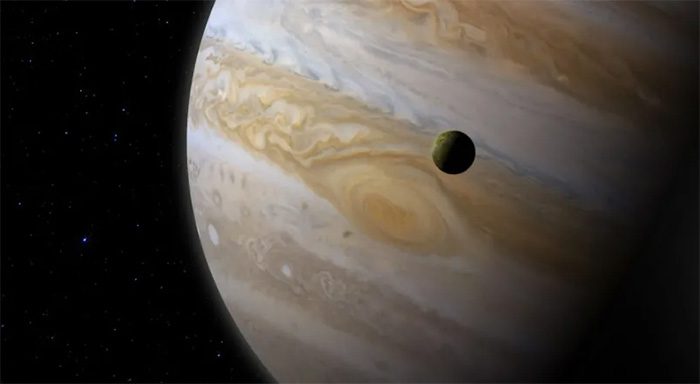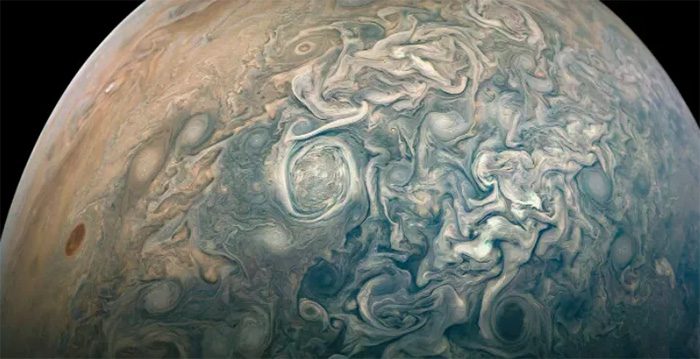“A star is a spherical celestial body made of plasma, emitting light and counteracting its own gravitational force through nuclear fusion reactions in its core.”
The smallest known star in our Milky Way galaxy is called EBLM J0555-57Ab, located 600 light-years away from us, with an average radius of about 59,000 km, slightly larger than Saturn. It is also the known star that supports hydrogen fusion in its core, a process that keeps stars shining until they run out of fuel. In our Solar System, there are two objects larger than this small star: the Sun and Jupiter—often referred to as “a giant scoop of ice cream” with an average radius of 69,911 km. But why is Jupiter considered a planet and not a star?
The answer is quite simple and brief: Jupiter does not have enough mass to fuse hydrogen into helium. EBLM J0555-57Ab has a mass about 85 times that of Jupiter, which is light enough to be a star; if it were lighter, it would also be unable to burn hydrogen. So, could Jupiter “ignite” to become a star, if we hypothesize that our Solar System had different characteristics?
Jupiter and the Sun Are More Similar Than We Think
While gas giant planets may not be stars, Jupiter is quite a complex entity. Its mass is 2.5 times that of all the other planets combined, making it a gas giant with a very low density: about 1.33 grams per cubic centimeter, compared to Earth’s density of 5.51 grams per cubic centimeter, which is four times denser than Jupiter.
However, Jupiter and the Sun have some fascinating similarities. The Sun’s density is 1.41 grams per cubic centimeter, comparable to that of Jupiter, and both of these objects are very similar in composition. By mass, the Sun is composed of about 71% hydrogen and 27% helium, with the remainder made up of a small amount of other elements. Jupiter, by mass, is about 73% hydrogen and 24% helium. For this reason, Jupiter is sometimes referred to as a “failed star”, but it remains unlikely that, for the objects of the Solar System, Jupiter will ever become a star.

Jupiter is quite a complex entity.
The fact is that stars and planets are formed through entirely different mechanisms. Stars are born when a dense mass of material in a molecular cloud collapses under its own gravitational force. As these stars rotate, they pull in more material from the surrounding cloud into a protoplanetary disk. As their mass—and thus their gravity—increases, the star’s core is compressed further, raising its temperature. Eventually, it becomes dense and hot enough to ignite its core and trigger nuclear fusion.
According to scientific understanding of star formation, when a star has finished accumulating material, the entire protoplanetary disk consists of remnants that support the formation of planets. Astronomers believe that for “gas giants” like Jupiter, the process (known as core accretion) begins with small rocks and dust in the disk. As they orbit a protostar, these pieces of material start to collide and stick together through electrostatic forces. Eventually, these growing masses reach a size large enough—about 10 times the mass of Earth—to attract more gas from the surrounding orbit due to their increased gravity.
From the moment of its formation, Jupiter gradually grew to its current mass of about 318 times that of Earth and about 1/1000 the mass of the Sun. Once it had consumed all the available material around it—which is quite small compared to the mass needed for hydrogen fusion—it stopped growing. This is why Jupiter has never been close to being large enough to become a star. Jupiter’s composition is similar to that of the Sun not because it is a “failed star”, but because it was born from the same molecular gas cloud that produced the Sun.

Jupiter sits right on the boundary of massive objects.
True Failed Stars
The vast universe also contains a class of objects known as “failed stars”. These are brown dwarfs, filling the gap between gas giants and other stars. These objects have a mass about 13 times that of Jupiter, large enough to support core fusion reactions—not with ordinary hydrogen, but with deuterium. This element, also known as heavy hydrogen, is an isotope of hydrogen with one proton and one neutron in its nucleus instead of just a single proton. Its nuclear fusion temperature and pressure are lower than those of hydrogen.
The reactions in the cores of these “failed stars” occur at lower masses, temperatures, and pressures, with deuterium fusion being an intermediate step towards hydrogen fusion for stars as they continue to accumulate mass. However, some objects never reach that mass and are referred to as brown dwarfs.
Since the existence of these stars was confirmed around 1995, we still do not know whether brown dwarfs are inactive stars or “ambitious” planets. However, some studies have shown that they form and exist like stars, from the breakdown of molecular clouds rather than through core accretion. And some brown dwarfs even fall below the mass conditions needed to burn deuterium, making them indistinguishable from planets.
Jupiter sits right on the boundary of massive objects, below the mass of a star. It is the smallest mass at which an object can form from these molecular clouds. Therefore, if Jupiter formed in this way, it could also be considered a “failed star”. However, data from NASA’s Juno spacecraft suggest that at least at one time, Jupiter had a solid core—which aligns with the hypothesis from the core accretion formation method.
One model suggests that the upper limit of a planet’s mass, formed through core accretion, is about 10 times less than the mass of Jupiter, equivalent to the mass of Jupiter before deuterium fusion.
Thus, fairly speaking, it should not be called a failed star, but it is not entirely correct to say it is a true star either. Understanding how it formed will help us better understand how the universe operates. Additionally, Jupiter is a magnificent, striped, stormy, swirling furnace in its own right, and without Jupiter, humanity might not even exist here.




















































